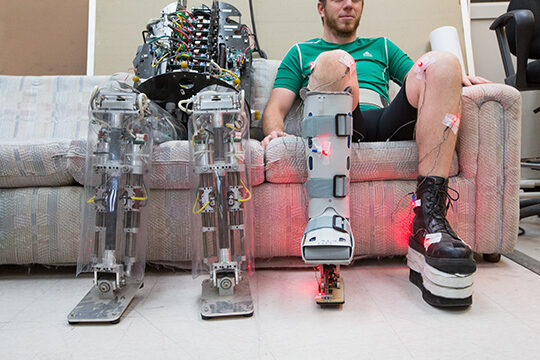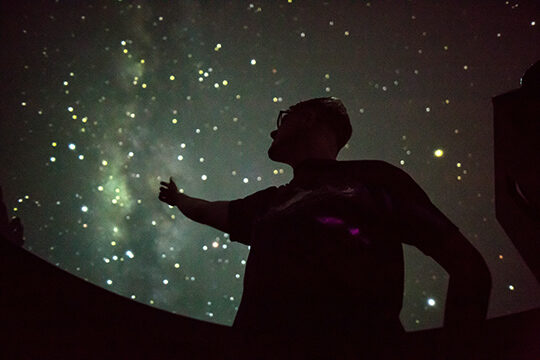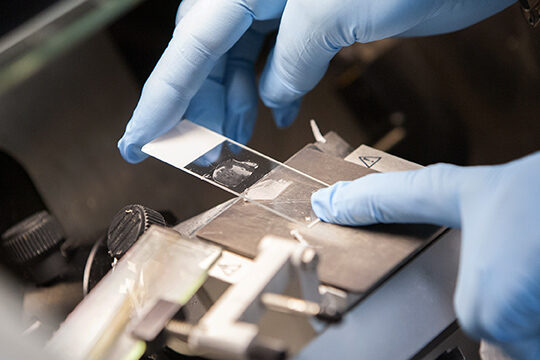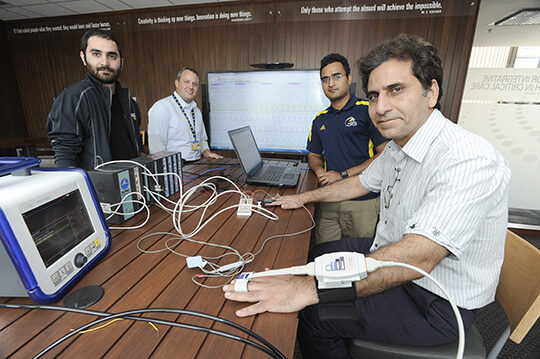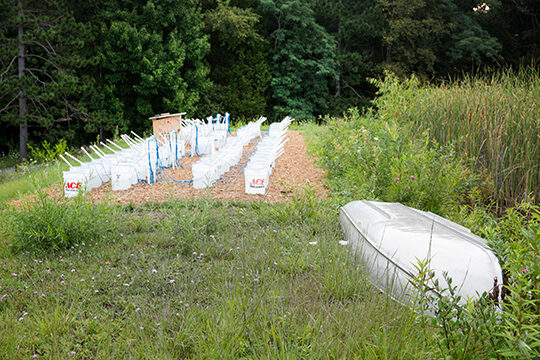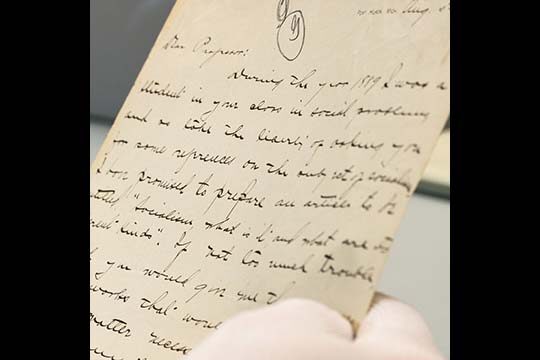Research: A day in the life at U-M
From prosthetic feet to phantom lungs, U-M scientists, scholars, and students collaborate in institutes, centers, libraries, and labs to redefine research and change our world. Research at Michigan is conducted in all 19 schools and colleges on the Ann Arbor campus, as well as at the U-M Flint and U-M Dearborn campuses.
-
Fancy footwork
Student Matt Robertson tests a prosthetic foot in U-M’s Human Biomechanics and Control Lab. Researchers in the lab study the mechanics, energetics, and control of human movement. (Photo: Austin Thomason, Michigan Photography.)
-
Seeing stars
Graduate student Tom Rice works among the stars in the Museum of Natural History’s Planetarium. The Planetarium has been a community astronomy resource since 1958. The facility offers a state-of-the-art digital, all-dome projection system that employs a powerful computer to reproduce and display the night sky. (Photo: Austin Thomason, Michigan Photography.)
-
Ghost in the machine
Here, Dr. Jonathan Rubin works on a “phantom lung” testing device to use with ultrasound imaging machines. Rubin is the William Martel Collegiate Professor of Radiology at the U-M Medical School. (Photo: Lon Horwedel, Michigan Photography.)
-
Frozen
In the Castro/Lowenstein Lab of Brain Tumor Biology & Therapeutics, researchers create slices of a cryogenically frozen material using the Leica CM 3050S. The machine is ideal for working with delicate specimens — for example, brain samples in neuroscience. The precise specimen orientation and the specimen feed system guarantee reproducible, thin, serial sections of maximum quality. (Photo: Daryl Marshke, Michigan Photography.)
-
Now hear this
Diane Prieskorn, a senior research program specialist in U-M’s Kresge Hearing Research Institute, analyzes a raccoon skull in the Cochlear Signaling and Tissue Engineering Laboratory, directed by Dr. Josef Miller. (Photo: Austin Thomason, Michigan Photography.)
-
It’s the little things…
Bonsai aficionado Jack Wikle displays some recent finery at the Matthaei Botanical Gardens and Nichols Arboretum. The facility’s collection began in 1977 with a gift of core specimens from the estate of Dr. Maurice Seevers, a former director of the U-M Department of Pharmacology and an ardent bonsai lover. Wikle, meanwhile, is the Ann Arbor Bonsai Society’s longest standing member. (Photo: Peter Matthews, Michigan Photography.)
-
Ring it up
A team in the Michigan Center for Integrative Research in Critical Care works in the Ideation Lab to develop a sensor ring that, when attached to a patient, can collect vital signs. (Photo: Lon Horwedel, Michigan Photography.)
-
A jarring moment
The U-M Museum of Zoology (UMMZ) serves as the nucleus for the study of animal diversity on campus. The facility focuses on the evolutionary origins of the planet’s animal species, their genetic information, and the ecosystems they form. UMMZ houses world-class collections that span almost 200 years of regional and global biodiversity supporting a multifaceted research and teaching program. (Photo: Eric Bronson, Michigan Photography.)
-
Bones
Researchers in the Mammal Division of the U-M Museum of Zoology maintain several collections of specimens, including a traditional skin and skeleton collection, a fluid collection with more than 15,000 specimens, and a post-cranial skeleton collection with more than 10,000 specimens. (Photo: Eric Bronson, Michigan Photography.)
-
Bird man
A massive collection of birds, including about 6,387 species and 40 hybrids, can be found in the U-M Museum of Zoology. All geographic regions are represented, with specimens from some 273 countries. (Photo: Eric Bronson, Michigan Photography.)
-
Rare books
At the William L. Clements Library, Dee Andrews examines an illustration from a title in the library’s Rare Books Collection. This book dates to the 17th or 18th century. The Clements is home to original resources for the study of American history and culture from the 15th-19th centuries. The library’s mission is to collect and preserve primary source materials, to make them available for research, and to support and encourage scholarly investigation of our nation’s past. The library is currently undergoing renovation and is housed in temporary off-campus quarters at 1580 E. Ellsworth Rd. (Photo: Daryl Marshke, Michigan Photography.)
-
Sunshine state
On a cloudy day, a member of the U-M Solar Car Team works on elements and details for the vehicle’s latest design. Earlier this month six team alumni and three current students traveled to the United Arab Emirates to compete in the inaugural Abu Dhabi Solar Challenge. And, oh yes, they won. (Photo: Daryl Marshke, Michigan Photography.)
-
Take it outside
Since 1930, U-M has maintained the Edwin S. George Reserve (ESGR) in Livingston County, Mich., to provide research and education opportunities in the natural sciences while preserving native flora and fauna. The ESGR is a 525-hectare fenced preserve. To date, more than 475 research papers have been published on studies carried out wholly or in part there. Some 81 PhD dissertations and 31 masters’ theses have resulted from graduate studies at the site. (Photo: Eric Bronson, Michigan Photography.)
-
Paper work
Terrence McDonald browses letters and photographs while researching Henry Carter Adams at the Bentley Historical Library. Adams was a U.S. economist and professor of political economy and finance at U-M from 1880-1921. McDonald is director of the Bentley Historical Library; he is an Arthur F. Thurnau Professor and professor of history at the College of Literature, Science & the Arts. The Bentley showcases the history of Michigan and U-M. Holdings include materials from more than 10,000 individual and organizational donors; these include some 10,000 maps, 80,000 printed volumes, and 1.5 million photographs. The Bentley also holds the archives of the U-M Athletic Dept. (Photo: Austin Thomason, Michigan Photography.)
-
Reality bites
Maggie Miller, a senior studying art and design, works with a three-dimensional laser camera to scan a set of teeth. The digital scan will then be used to print another set of teeth using a 3-D printer. (Photo: Roger Hart, Michigan Photography.)
-
Details
The U-M Herbarium is home to some of the finest botanical collections in the world. The 1.7 million specimens of vascular plants, algae, bryophytes, fungi, and lichens — combined with the expertise of the faculty-curators, students, and staff — provide a world-class facility for teaching and research in systematic biology and biodiversity studies. (Photo: Eric Bronson, Michigan Photography.)
-
Words to live by
This handwritten message on a whiteboard hanging in U-M’s Life Sciences Institute (LSI) captures the heart and soul of research at Michigan. The LSI is a nucleus of biomedical research at the University, and the institute’s faculty members hold academic appointments in the Medical School, the College of Pharmacy, and 14 departments including Chemistry, Cell and Developmental Biology, Physiology, Human Genetics, Bioinformatics, Hematology and Oncology, and Medicinal Chemistry. (Photo: Austin Thomason, Michigan Photography.)

